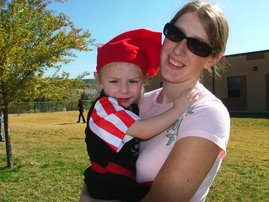
This is a project where we had to make a model of a working limb. It is going to show how muscle is attached to bone and how movement happens.
In this picture you can see the supplies I used. Mainly play dough, some paper and pipe cleaners.
This next picture is of the first bone in my model. It is the femur (the thigh bone) you can also see where the ball at the top of the bone would go into the hip joint.

This next picture is of the bone in your lower leg. They are the tibia and the smaller bone is the fibula.

This picture is showing a knee cap at the joint where the two bones meet. This bone is called the patella.
This image is of the whole leg bone.


This image is of the whole leg bone.

Here is another showing where the foot would be.
 The red play dough on top of the white bone is meant to represent muscle tissue. This muscle group is the quadriceps femoris. These are the muscles on the front side your thighs.
The red play dough on top of the white bone is meant to represent muscle tissue. This muscle group is the quadriceps femoris. These are the muscles on the front side your thighs.

 The red play dough on top of the white bone is meant to represent muscle tissue. This muscle group is the quadriceps femoris. These are the muscles on the front side your thighs.
The red play dough on top of the white bone is meant to represent muscle tissue. This muscle group is the quadriceps femoris. These are the muscles on the front side your thighs.
This picture has yellow playdough representing the tendons that attach muscle to bone. This allows the muscle to move the bone.
 This picture is showing the movement at the joint. The leg is bent.
This picture is showing the movement at the joint. The leg is bent.

 This is a picture of the schwann cells or myelin sheath that cover a neuron.
This is a picture of the schwann cells or myelin sheath that cover a neuron.


This picture is of all the parts of a muscle cell working together to contract or relax. Muscles contract by impulses being sent to a T tubules calcium is released and the sarcomeres shorten. You can see in the model that this is a sliding filament process. "The actin filaments slide past the myosin filaments an approach one another." (Pg232 Mader)

Relaxed
 This picture is showing the movement at the joint. The leg is bent.
This picture is showing the movement at the joint. The leg is bent.
The blue play dough represents the neurons that carry a message to the muscle telling it to contract. This is also called an action potential or nerve implulse.
 This is a picture of the schwann cells or myelin sheath that cover a neuron.
This is a picture of the schwann cells or myelin sheath that cover a neuron.
This is a model of Motor neuron notice the cell body with a nucleus. The long strand is the axon it has schwan cells in light blue covering it. At the end of the strands are axon terminals. Nerotransmitters are stored in the axon terminals. They help send messages from one neuron across to the next.

This is an image of how an action potential is carried out on a myelinated axon. The action potential or nerve impulse is kind of passed on from one section to the next. This happens very quickly.

This is an image of how an action potential is carried out on a myelinated axon. The action potential or nerve impulse is kind of passed on from one section to the next. This happens very quickly.

This picture is of all the parts of a muscle cell working together to contract or relax. Muscles contract by impulses being sent to a T tubules calcium is released and the sarcomeres shorten. You can see in the model that this is a sliding filament process. "The actin filaments slide past the myosin filaments an approach one another." (Pg232 Mader)

Relaxed
In conclusion you can see how all of these parts help us move. Fom our brain sending a nerve impulse down telling use to move our limb. To the tendons making it possible for the muscle to move the bone. The whole system works together to cause movement.
Work Cited:
Madder, Sylvia S. “Human Biology” 10th ed. New York: McGraw-Hill, 2007.
Madder, Sylvia S. “Human Biology” 10th ed. New York: McGraw-Hill, 2007.


1 comment:
Katie, perfect job on this unit—what can I say—keep it up, just one to go!
LF
Post a Comment